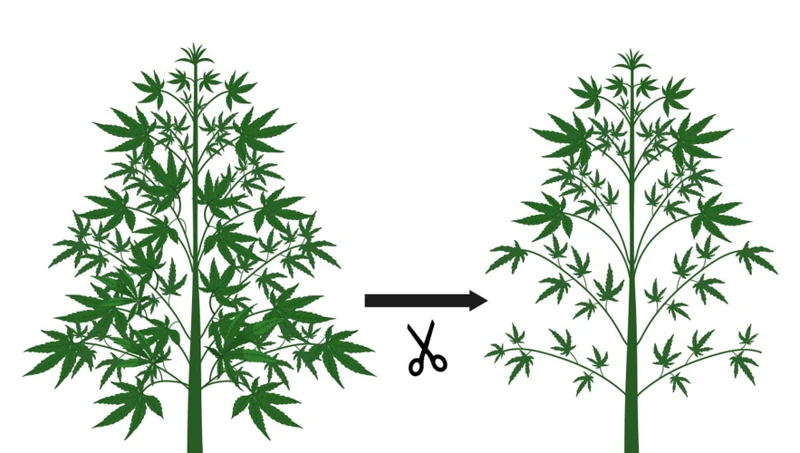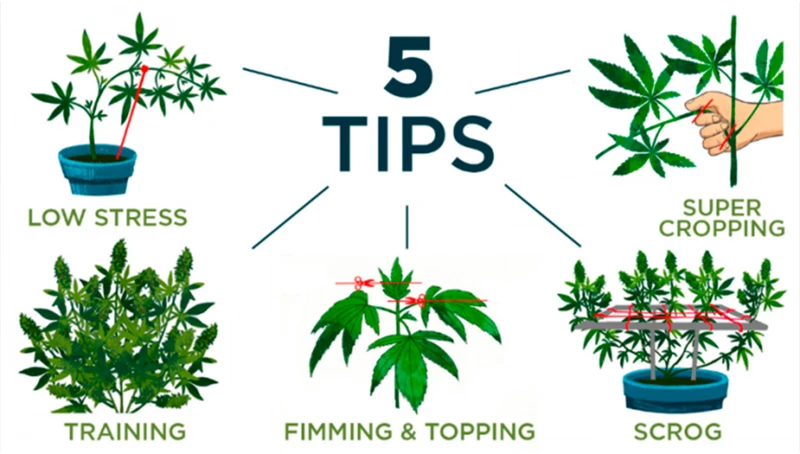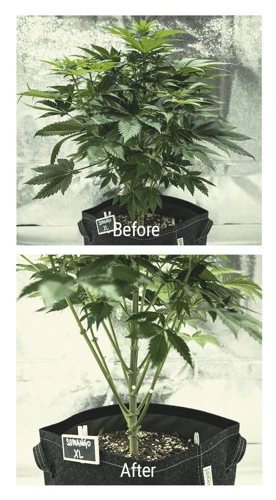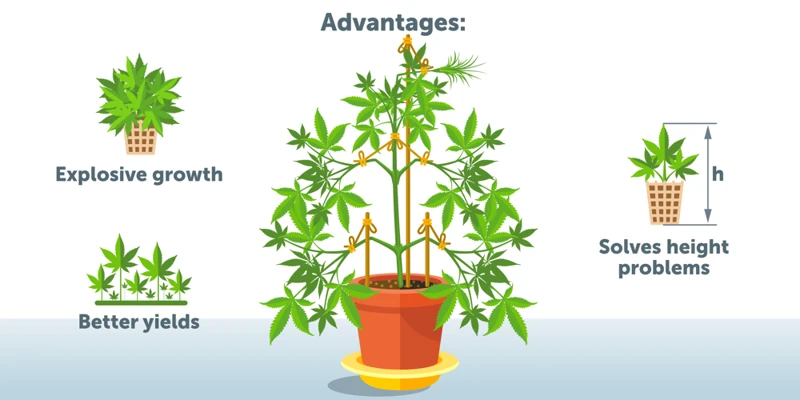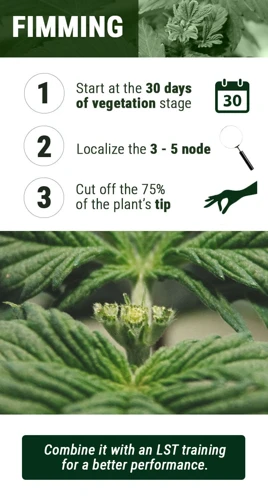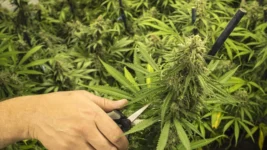
5 Essential Trimming Techniques for Maximum Cannabis Yield
As a cannabis cultivator, the ultimate goal is to produce bigger and better yields. However, achieving this can be a challenge, requiring precision, knowledge, and patience. One key technique in maximizing your yield is proper trimming. With the right techniques, you can control how your plant grows, ultimately influencing its size, shape, and potency. In this article, we will explore five essential trimming techniques for bigger yields. From defoliation and topping to lollipopping, supercropping, and FIMming, we will examine each technique in detail, outlining when and how to use them. But first, let’s delve into why trimming is so important for cannabis growth.
1. Defoliation
Contents
As a cannabis grower, you may have heard of a technique called defoliation and wondered what it means for your plants. Defoliation involves removing some of the leaves from your plants, which may seem counterintuitive, but can actually lead to bigger yields if done correctly. However, as with any trimming technique, timing and method are crucial to its success. In this section, we will explore the what, when, and how of defoliation for cannabis cultivation.
What is Defoliation?
Defoliation is a pruning technique where you remove some of the plant’s leaves to increase airflow and light penetration. It is an essential technique for increasing yields which can help you to get the maximum harvest from your plants. Here are some important details to know about defoliation:
- Why defoliate? Defoliation is important as it can help to increase light penetration into the lower parts of the plant canopy, allowing for better bud growth. It also helps to ensure that the plant isn’t wasting energy and nutrients on leaves that aren’t contributing to the overall health of the plant.
- How to defoliate? Make sure to use clean and sterilized scissors when defoliating your plants. You can start pruning the plant from the bottom and work your way up, removing any leaves that are dead, yellowing, or blocking light from reaching the lower parts of the plant. However, it’s essential to remember not to over-defoliate as it can stress the plant and negatively impact its growth and yield.
- When to defoliate? Defoliate your plants during the vegetative stage or early flowering stage. This period is essential as it ensures that the plant concentrates its energy and resources on developing buds instead of leaves. Avoid over-pruning, particularly during the flowering stage, or it can lead to stunted growth and reduced yields.
Proper defoliation technique ensures a healthy growing environment for your plants and maximizes yields. Remember to monitor your plants’ growth and health closely after defoliation. If done correctly, this technique can help to ensure a bountiful harvest from your cannabis plants.
When and How to Defoliate
When it comes to defoliating your plants, timing is key. It is not something that should be done routinely or without careful consideration. The best time to defoliate is after the vegetative stage and early into the flowering stage, during the first couple of weeks. This is because the plant is still developing its flowers and needs as much energy as possible to do so. Defoliating too late in the flowering stage can actually be detrimental to your yield as it can stress the plant and result in smaller buds.
Here are some steps to take when defoliating your plants:
- Start with a clean and sterilized pair of scissors or pruning shears. This will help prevent the spread of any diseases or pests that could harm your plants.
- Choose the right leaves to remove. Look for any leaves that are blocking light from reaching the lower branches or any that are touching each other and creating a humid environment that could lead to mold. Removing leaves from the lower portion of the plant can also help redirect energy to the top of the plant where the buds will form.
- Be cautious and avoid removing too many leaves at once. Removing too many leaves can stress the plant and slow down its growth. It is recommended to remove no more than 20-30% of the plant’s leaves during any one defoliation session.
- Remove the leaves carefully. Gently pull the leaves away from the stem and use your sterilized scissors or pruning shears to cut them off as close to the stem as possible without damaging the plant.
- Watch and wait for the results. Give your plant some time to recover from the defoliation and monitor its growth. You should start to see improved light penetration and air flow, which can result in bigger yields.
Defoliation can be a useful technique to increase yields, but it should be done with care and attention to timing and technique.
2. Topping
As a cannabis grower, you may have heard of the topping technique, but are not quite sure what it involves. Topping is a method that involves cutting off the top part of the main stem of a plant to encourage the growth of lower branches. This may seem intimidating at first, but with the right technique and timing, topping can lead to bigger yields and more desirable plant shapes. Let’s dive into the details of what topping is and how to do it properly.
What is Topping?
Topping is a pruning technique that involves removing the top of a plant’s main stem or central cola, encouraging more lateral growth and creating a bushier plant. This technique allows for greater control over the plant’s shape and size, and ultimately results in bigger yields.
During topping, the top of the plant is removed above a node or leaf set, which encourages new growth from the lower nodes. This process should be done during the vegetative stage of the plant’s growth, before it begins to flower.
Topping helps to increase the yield by allowing the plant to focus its resources on lateral growth, rather than just upward, resulting in more bud sites. This technique also helps to keep the plant short and more manageable, especially when growing indoors where space is limited.
The following table summarizes the key elements of topping, including what it is, when it should be done, and how it can benefit your plant:
| Topping | Definition | When to do it | Benefits |
|---|---|---|---|
| Topping | Pruning technique that involves removing the top of a plant’s main stem or central cola. | During the vegetative stage of the plant’s growth, before it begins to flower. | Encourages more lateral growth and creates a bushier plant, resulting in bigger yields. Allows for greater control over the plant’s shape and size. Keeps plant short and more manageable, especially when growing indoors where space is limited. |
When and How to Top
Topping is a technique that can help increase the yield of cannabis plants. Essentially, it involves removing the top of the plant to encourage lateral growth. This results in more branches and ultimately a larger yield of buds.
When to Top:
– It is best to top your plant when it is still young and has about five to six nodes. This will ensure that the plant has enough time to recover and continue to grow before flowering.
– It is important to avoid topping too late in the vegetative stage, as this can stress the plant and negatively impact yield.
How to Top:
1. Prepare your tools: To top your plant, you will need a sharp pair of scissors or pruning shears. It is important to sterilize your tools before and after cutting to prevent the spread of disease or pests.
2. Locate the top node: Look for the newest growth tip at the very top of the plant. This is where you will make your cut.
3. Make the cut: Use your scissors or pruning shears to cut off the top of the plant just above the newest growth tip.
4. Monitor recovery: Your plant may take a few days to recover from topping. During this time, it is important to keep an eye on the plant and make sure it is receiving enough light and nutrients. Once your plant has recovered, you should begin to see new branches and growth.
Remember to only top your plant once to avoid causing irreparable damage. Topping can be a useful technique for increasing yield, but it is important to use it at the right time and with care.
3. Lollipopping
If you’re looking to enhance your cannabis plant’s yield and overall quality, lollipopping is one of the essential trimming techniques that you should consider. This technique involves removing the lower branches and leaves of your plant to redirect its energy towards producing larger, higher-quality buds on the top canopy. It can seem daunting at first, but once you get the hang of it, lollipopping can help you grow crops with a higher potency and better taste. In the following sections, we’ll delve into what lollipopping is, why and how to do it properly, and the benefits you can expect from this trimming practice.
What is Lollipopping?
Lollipopping is a pruning technique that involves trimming the lower parts of the cannabis plant to promote bigger yields from the top buds. This technique is named after the shape of a lollipop, where the top of the plant is the round candy and the remaining stem is the stick.
Reasons for Lollipopping
The primary reason for lollipopping is to ensure that all the plant’s energy is focused on producing the top buds rather than on the lower parts of the plant. This is because the lower buds are often smaller and less potent than the top buds, thus wasting valuable nutrients that could be better used to promote the growth of high-quality top buds.
Another reason for lollipopping is to improve air circulation near the base of the plant. Trimming the lower leaves and branches allows air to flow freely, decreasing the likelihood of any mold or mildew growth.
When to Lollipop
Lollipopping should be done during the vegetative stage, once the plant has grown to a considerable size. It’s best to wait until the plants have a few sets of leaves and are at least 6-8 inches tall. Lollipopping at this stage ensures that the plant can quickly recover from the shock of the trimming process and continue to grow vigorously during the flowering stage.
How to Lollipop
To lollipop a plant, follow these simple steps:
- Get a pair of sharp pruning shears.
- Cut off all the lower branches and leaves that are too small and that won’t make it to the canopy level.
- Be careful not to cut off any branches or leaves that are essential to the plant’s growth.
It’s important to note that you should not remove more than one-third of the plant’s foliage at any one time to avoid stunting its growth.
Once the lollipopping is complete, the cannabis plant will have a cleaner and more organized look, and the top buds will have more space to flourish.
When and How to Lollipop
Lollipopping is a pruning technique used to remove the lower branches of the plant. This technique is named after the shape of the plant, which resembles a lollipop after the lower branches are removed. Lollipopping is done to improve airflow and light penetration to the top of the plant, which promotes the growth of larger buds.
When deciding to lollipop, it’s important to wait until the plant has developed a significant number of branches, usually between 3-5 nodes. Using lollipopping too early can cause stunted growth and reduce the total yield of the plant. Additionally, it’s important not to overdo it—removing too many branches can shock the plant and slow down growth.
To lollipop, you’ll need a pair of pruning shears or scissors. It’s important to use sharp and clean tools to avoid damaging the plant or introducing pests and diseases. Follow these steps:
| Step | Instructions |
|---|---|
| 1 | Identify the branches to be removed. Look for branches that are low on the plant and unlikely to produce large buds. |
| 2 | Use your pruning shears or scissors to remove the branches at the stem. Make sure to cut as close to the stem as possible without damaging it. |
| 3 | Repeat steps 1-2 for all branches that need to be removed. |
| 4 | Clean up the area around the plant, removing any debris and dead leaves. |
After lollipopping, the plant may need a few days to recover. It’s important to monitor the plant for any signs of stress or damage, such as wilting or yellowing leaves. Lollipopping is a great way to improve the yield and quality of your cannabis crop.
4. Supercropping
One interesting technique to increase yields and maximize the potential of your cannabis plants is a process called supercropping. This method involves strategically damaging specific parts of the plant to create a more controlled growth pattern, which can result in larger yields and denser buds. While it may seem counterintuitive to harm your plants, when done correctly, supercropping can lead to a more productive and efficient harvest. Let’s dive into the details of this interesting pruning technique.
What is Supercropping?
Supercropping is a plant training technique that involves gently damaging the stem of the plant to encourage it to develop sturdier branches and grow more buds. This technique is often used to increase yields and improve the overall health of the plant.
How does Supercropping Work?
Supercropping works by causing the stem of the plant to undergo a physiological response called phototropism. When the stem of the plant is gently bent or squeezed, it creates small breaks in the tissue called “stress points”. In response to this stress, the plant releases hormones that are responsible for cell division and elongation, causing the plant to grow stronger and more resilient.
When to Supercrop?
The best time to supercrop is during the vegetative stage of growth, when the plant is still developing new branches and foliage. It is important to avoid supercropping during the flowering stage, as it can cause damage to the developing buds and reduce overall yield.
How to Supercrop?
To supercrop a plant, use your fingers to gently squeeze and bend the stem between your thumb and forefinger until you feel a slight “pop” or crack. This indicates that a stress point has been created. Be careful not to apply too much pressure, as this can cause the stem to break entirely.
After creating the stress point, gently bend the stem so that it is at a 90-degree angle to the main stem or to the ground. Use soft ties to hold the bent stem in place for a few days, allowing the plant time to heal and grow stronger.
Repeat this process on each branch of the plant, taking care not to supercrop too many branches at once as this can be too stressful for the plant. With proper technique and patience, supercropping can result in bigger yields and healthier plants.
When and How to Supercrop
Supercropping is a trimming technique that involves gently stressing the stems of the cannabis plant to create new, stronger growth. This technique is typically done during the plant’s vegetative stage and can result in higher yields and more potent buds. But when and how to supercrop?
When to Supercrop:
– Supercropping is best done during the vegetative stage of the cannabis plant. This is when the plant is growing its leaves and stems, but has not yet begun to flower.
– It is important to wait until the plant is sturdy and healthy enough to handle the stress of supercropping. Typically, this means waiting until the plant has several nodes or sets of leaves.
How to Supercrop:
1. Choose the stem you want to supercrop. Look for a stem that is tall and thin, and has a node or set of leaves about halfway up.
2. Using your fingers or blunt object, gently compress and bend the stem back and forth until it becomes pliable. Be careful not to break the stem.
3. Once the stem is pliable, slowly bend it over at a 90-degree angle, about halfway up the stem.
4. Hold the stem in place for a few seconds to ensure it stays bent.
5. Apply some plant tape or other soft binding material to support the newly bent stem.
6. Repeat the process with other selected stems.
Supercropping can be a tricky technique to master, and it is important to be careful not to cause too much stress to the plant. But with some practice, it can be a highly effective way to improve your cannabis yield and potency. Remember to always give your plant time to recover after supercropping, and provide it with plenty of nutrients and water to support healthy growth.
5. FIMming
One of the most popular techniques used by experienced growers to increase the number of colas and promote bushier growth is FIMming. This technique involves pinching off a portion of the plant during the vegetative phase to encourage the growth of multiple branches. It allows growers to make the most out of the plant’s vegetative growth and can lead to bigger yields at harvest time. In this section, we will cover everything you need to know about FIMming, from what it is to when and how to perform it on your plants.
What is FIMming?
FIMming is a pruning technique that allows for increased yields by promoting bushier growth without the negative effects of topping. The term “FIM” stands for “fuck, I missed” as it was originally an accidental pruning technique, but has since been adopted as a deliberate method of plant training.
How it works: FIMming involves cutting off a portion of the newest growth tip of a cannabis plant, which can stimulate new growth from lower nodes and promote a bushier structure. The FIM cut should be made just above the third or fourth node from the top, leaving a portion of the new growth intact.
Benefits: FIMming can help to increase yields by promoting more lateral growth and creating a bushier canopy. This can lead to the production of more flowering sites, resulting in a greater overall yield.
When to FIM: FIMming is most effective during the vegetative stage when the plant is actively growing. It’s important to wait until the plant has at least 4 nodes before attempting to FIM.
How to FIM: To FIM, use a sharp, clean pair of scissors or shears to make a clean cut just above the third or fourth node from the top of the plant, leaving a small amount of the new growth intact. It’s important to sterilize your cutting tool with isopropyl alcohol before making the cut to prevent the spread of disease.
FIMming at a glance:
| FIMming | Topping |
|---|---|
| Promotes bushier growth | Promotes taller growth |
| Less stress on the plant | More stress on the plant |
| Cuts off a portion of the newest growth tip | Cuts off the entire top of the plant |
When and How to FIM
FIMming, or “Fuck, I Missed” is a technique that involves selectively cutting the newest growth tips of a plant to promote bushier growth. This method can be used at various stages of the plant’s life cycle, but it’s crucial to do it during the vegetative stage before it reaches the flowering stage. Here are the steps to effectively perform FIMming:
- Ensure the plant is healthy: Before going ahead with any trimming technique, it’s crucial to check the plant’s overall health. FIMming requires the plant to recover from the stress caused by the cut, so if it’s already struggling for any reason, it’s better to skip this method entirely.
- Identify the right spot to cut: Look for the newest growth tips that are still developing. They should be about 2-3 nodes down from the main cola (the top of the plant). Use a sharp and sterile pair of scissors or pruning shears to make a precise cut.
- Make a snip: Instead of cutting the tip of the leaf completely, it’s essential to leave a portion of the tissue behind. Cut about 80-90% of the newest growth tip, leaving a small portion intact. This method ensures that the plant will still have growth hormones in the tissue left behind, which promotes bushier growth.
- Wait for results: About a week later, development will start again from the remaining growth tips, and the plant will start to push out new branches. FIMming can lead to four or more colas developing from a single stem, making it a highly effective technique to increase yield.
FIMming is an effective trimming technique that can increase yields and promote bushier growth. It’s perfect for growers who want to maximize their space and yield. Remember to take your time, use sterile tools, and ensure the plant is healthy.
Clean Up
After learning about the essential trimming techniques for bigger yields, it’s important to make sure you properly clean and maintain your trimming tools. Neglecting to do so can lead to the spread of pests and diseases, as well as dull blades which can damage your plants. In this section, we’ll go over some tips for keeping your tools in top condition and preventing any potential issues.
How to Maintain Your Trimming Tools
Proper maintenance of your trimming tools is essential to ensure their longevity and efficiency. Below are some tips on how to maintain your trimming tools:
| TIP | DESCRIPTION |
|---|---|
| 1. Keep Them Clean | Clean your trimming tools after each use to prevent buildup of plant material and debris. Use a damp cloth or alcohol wipe to remove any residue from the blades and handles. |
| 2. Lubrication | Apply a small amount of lubrication oil to the joint of the scissors or shears to keep them functioning smoothly. This will also help prevent rusting and corrosion. |
| 3. Sharpening | Regularly sharpen your trimming tools to maintain their cutting ability. Use a sharpening stone or a professional sharpening service if needed. |
| 4. Storage | Store your trimming tools in a dry, cool, and secure location to prevent damage and maintain their quality. Use a protective case or sheath to prevent damage to the blades. |
| 5. Maintenance Schedule | Set aside time to regularly maintain and clean your trimming tools. This will ensure they remain in good condition and last for a long time. |
By following these tips, you can ensure that your trimming tools remain effective and efficient, and that you get the most out of your investment. Remember to always prioritize safety by using gloves and protective gear when trimming, and to dispose of blades and scissors safely and responsibly. By maintaining your tools properly, you’ll be able to enjoy bigger yields and a more enjoyable trimming experience.
Cleaning and Sterilization
Keeping your trimming tools clean and sterilized is crucial to prevent the spread of diseases and pests. Here are some tips for cleaning and sterilizing your tools:
- First, remove any plant matter or debris from your tools using a brush or cloth. This will prevent the spread of any disease or pests.
- Next, wash your tools with warm soapy water. Use a mild detergent and scrub thoroughly to remove any remaining plant matter, dirt, or debris. Rinse well with water and dry thoroughly.
- After cleaning, sterilize your tools to kill any remaining bacteria or pests. You can use isopropyl alcohol, hydrogen peroxide, or a commercial sterilizing solution. Soak your tools in the sterilizing solution for at least 5 minutes, or according to the manufacturer’s instructions. Rinse well with water and dry thoroughly.
- Store your tools in a dry, clean place. This will prevent rust and corrosion and ensure that your tools are ready to use when you need them.
- Repeat the cleaning and sterilization process after each use. This will ensure that your tools are always clean and free of disease or pests.
By following these simple cleaning and sterilization tips, you can ensure that your tools are always clean and free of diseases and pests. This will not only help to protect your plants but also contribute to a healthier and more productive garden.
Conclusion
In conclusion, mastering trimming techniques is essential for any cannabis grower who wants to achieve bigger yields. From defoliation to FIMming, each technique offers unique benefits that can help increase the quality and quantity of your cannabis harvest.
However, it’s crucial to note that these techniques require precision and caution as improper execution can harm your plants. It’s also essential to use high-quality trimming tools and maintain their cleanliness and sterilization.
Ultimately, finding the right trimming technique or combination of techniques for your cannabis plants can be a trial and error process. It’s important to experiment and observe the effects of each method on your plants to determine the most suitable approach.
So, take your time, be patient, and remember to prioritize the health and well-being of your cannabis plants above all else. With proper trimming techniques and good care, you can achieve the optimal yield and quality from your harvest.
Frequently Asked Questions
What are the benefits of trimming cannabis plants?
Trimming cannabis plants helps to increase yields by redirecting nutrients to the parts of the plant that will produce the most flowers. This also helps to control the growth of the plant and improve overall quality.
What is defoliation and why is it important?
Defoliation is the process of removing leaves from the cannabis plant. This helps to improve airflow, prevent mold and mildew, and redirect nutrients to the parts of the plant that need them the most.
Can defoliation harm my cannabis plants?
Defoliation can harm your cannabis plants if you remove too many leaves at once. It is important to only remove a small percentage of leaves each time and to monitor the plant’s response to ensure it is not stressed.
What is topping and how does it increase yields?
Topping is the process of removing the top of the main stem of the cannabis plant. This causes the plant to produce two new main stems, which can result in a higher yield of flowers.
Can topping harm my cannabis plants?
Topping can harm your cannabis plants if you do not do it correctly. It is important to only top the plant once it has developed several sets of leaves and to ensure you use clean and sharp trimming tools to avoid damaging the plant.
What is lollipopping and when should I use it?
Lollipopping is the process of removing the lower growth on the cannabis plant that will not produce many flowers. This helps to redirect nutrients to the top of the plant and improve overall quality and yield.
What is supercropping and how do I do it?
Supercropping is the process of intentionally damaging the branches of the cannabis plant in order to redirect nutrients to other parts of the plant. This can be done by gently bending or twisting the branches, but it is important to be careful not to break them.
What is FIMming and how is it different from topping?
FIMming is a form of topping that involves removing only a portion of the main stem of the cannabis plant. This helps to redirect nutrients to other parts of the plant, but can result in a smaller yield of flowers than traditional topping.
How do I maintain my trimming tools?
It is important to regularly clean and oil your trimming tools to ensure they are sharp and effective. You should also store them in a dry and cool place to prevent rusting and damage.
Why is cleaning and sterilization important when trimming cannabis plants?
Cleaning and sterilization helps to prevent the spread of mold, mildew, and other contaminants between plants. This is especially important if you are growing multiple plants in the same space.

